Physical Address
304 North Cardinal St.
Dorchester Center, MA 02124
![]() For videos accompanying this chapter see ExpertConsult.com. See inside cover for access details.
For videos accompanying this chapter see ExpertConsult.com. See inside cover for access details.
The surgical management of patients with strabismus begins with a careful history and examination to understand current patient concerns, past treatments, and to gain an understanding of the patient’s overall medical condition. Treatment of strabismus may involve one or more of the following: observation alone, correction of refractive error, orthoptics, patching, botulinum toxin injection, and surgery. This chapter will provide an overview of the surgical treatment of strabismus.
The surgical indications, goals, and potential risk, and alternatives should be discussed with the patient prior to surgery. Patients should understand ongoing follow-up needs and it is important for patients to be aware of the fact that more than one treatment and/or procedure could be necessary to adequately correct their strabismus. For our patients, we typically disclose the following general risks: (1) the need for additional treatment or surgery; (2) double vision; and (3) partial or total blindness.
Traditionally, the goal of strabismus treatment has been to re-align the visual axes in order to eliminate diplopia, or to maintain or restore binocular vision. Other functional indications for surgery might include an attempt to improve or eliminate an abnormal head posture, eliminate abnormal eye movements, increase the area of single binocular vision in a patient with an incomitant deviation, or increase the functional visual field of a patient with esotropia. Restoring the normal anatomical position of the eyes without any other potential benefit is also a well-accepted indication for surgery. The psychosocial benefit of surgery for patients with strabismus has now been well documented, even in patients who may not achieve any other functional visual benefit.
An understanding of the relevant anatomy and anatomical variations is an important prerequisite to performing strabismus surgery. The strabismus surgeon must not only be familiar with the anatomy of the extraocular muscles, but must also be cognizant of adjacent structures in the orbit and the ocular adnexa.
The conjunctiva is often inappropriately considered to be little more than a structure that must be incised to gain surgical access to the extraocular muscles. An understanding and recognition of key features of the conjunctival anatomy, especially medially, is necessary to perform appropriate conjunctival incisions to optimize access to the extraocular muscles, while reducing the risk of complication.
The conjunctiva is a mucous membrane that covers the posterior surface of the eyelids and the anterior surface of the globe with the exception of the cornea ( Fig. 88.1 ). The bulbar conjunctiva merges with the stroma and epithelium of the cornea. The palpebral conjunctiva begins on the lid margin at the mucocutaneous junction and is tightly adherent to the underlying tarsus. The conjunctiva in the fornices is loose and is reflected into several folds, allowing movements of the globe not to be limited by connections between the palpebral and bulbar conjunctiva.
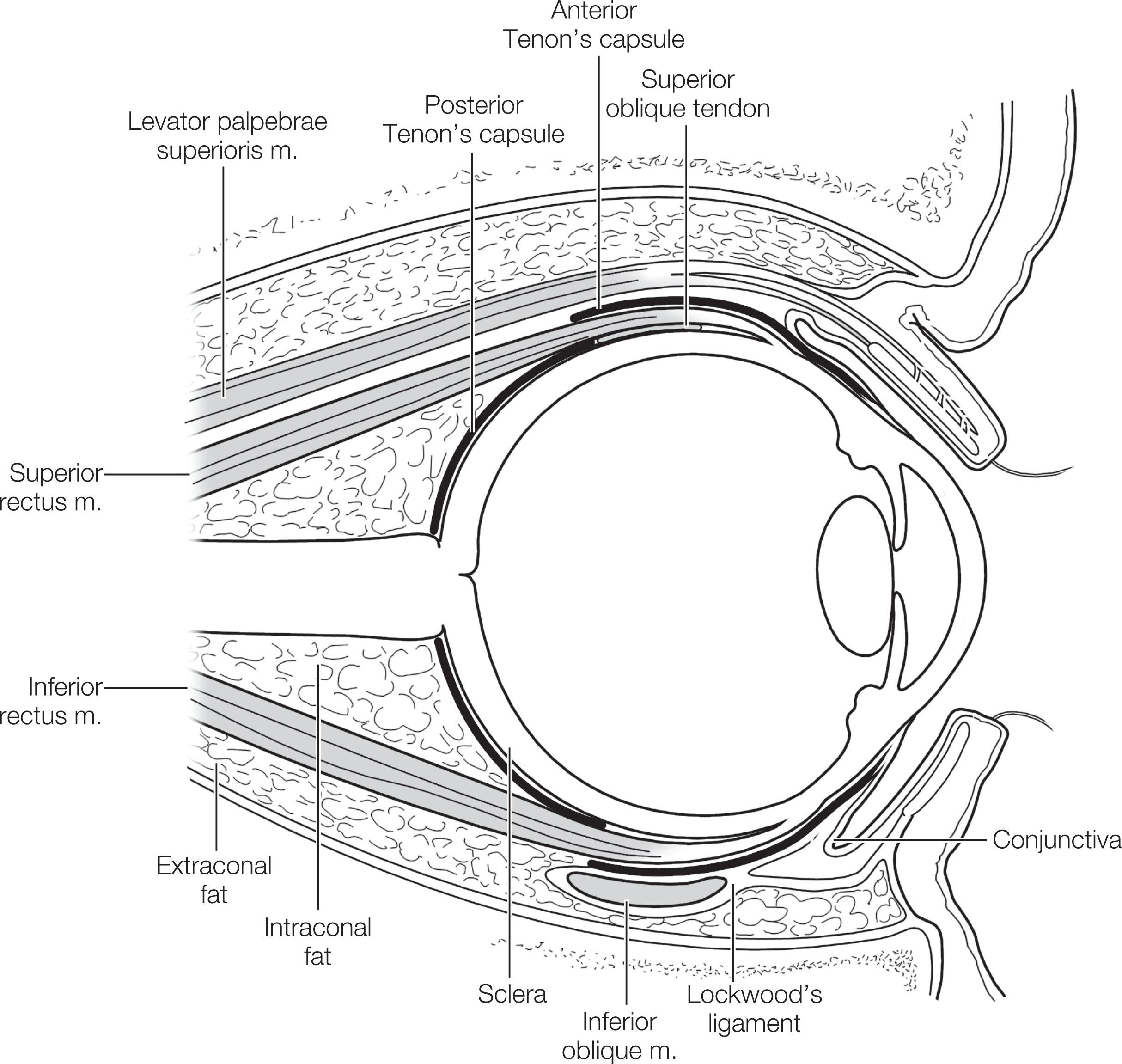
There is some redundancy of the conjunctiva so that excision of small portions of the conjunctiva is well tolerated without significantly altering its appearance or function. Only the bulbar conjunctiva is routinely incised during strabismus surgery. A fold of conjunctiva, known as the plica semilunaris conjunctivae (referred to simply as plica here), is present in the medial angle of the conjunctiva and represents a fold in the bulbar conjunctiva. When malpositioned or accidentally incised during strabismus surgery, the result can be a significant cosmetic and/or functional problems.
The sclera is composed of densely packed collagen lamellae. It is continuous with the dura mater of the optic nerve. It is continuous across the optic nerve head, forming the lamina cribrosa. The sclera is penetrated by a variety of vascular and neural structures anteriorly and posteriorly. The thickness of the sclera varies with age. It is typically thinnest in a newborn. The thickness of the sclera varies depending on its location on the globe. The sclera is thinnest behind the insertions of the rectus muscles, where its thickness is approximately 0.45 mm, a fact that is important to the strabismus surgeon since sutures may need to be passed into this thin area of the sclera to recess a rectus muscle. The sclera is approximately 0.6–0.7 mm thick at the corneal limbus and 1.1–1.3 mm thick at the posterior pole.
The globe is suspended within the bony orbit by a fascial system, the bulk of which is known as Tenon’s capsule. Tenon’s capsule is a condensation of fibrous tissue that covers the globe from the entrance of the optic nerve at the posterior aspect of the globe extending to within 1 mm of the corneal limbus, where it fuses with the overlying conjunctiva. Tenon’s capsule is thick and readily manipulated surgically in young patients, but becomes thin and fragile in older patients. A potential space exists both deep and external to Tenon’s capsule known as the episcleral space (also known as sub-Tenon’s space) and the subconjunctival space, respectively. These spaces are important during strabismus surgery, as they must be entered in order to gain access to the extraocular muscles. Several large and small structures penetrate Tenon’s capsule including the optic nerve, the extraocular muscles, the vortex veins, and numerous other neurovascular structures.
The extraocular muscles penetrate Tenon’s capsule to enter the episcleral space, coursing toward their insertions into the sclera ( Fig. 88.2 ). It is in the episcleral space, containing a length of about 7–10 mm of the rectus muscles, that the majority of extraocular muscle surgery is performed. After entering the episcleral space, the muscles have no sheath, but instead are covered by episcleral connective tissues that are loosely fused with the muscle. This tissue expands laterally along the edges of the muscles to form the intermuscular membrane and is present all the way to the muscle insertion. These tissues fuse with Tenon’s capsule posteriorly, where the muscles penetrate Tenon’s capsule.
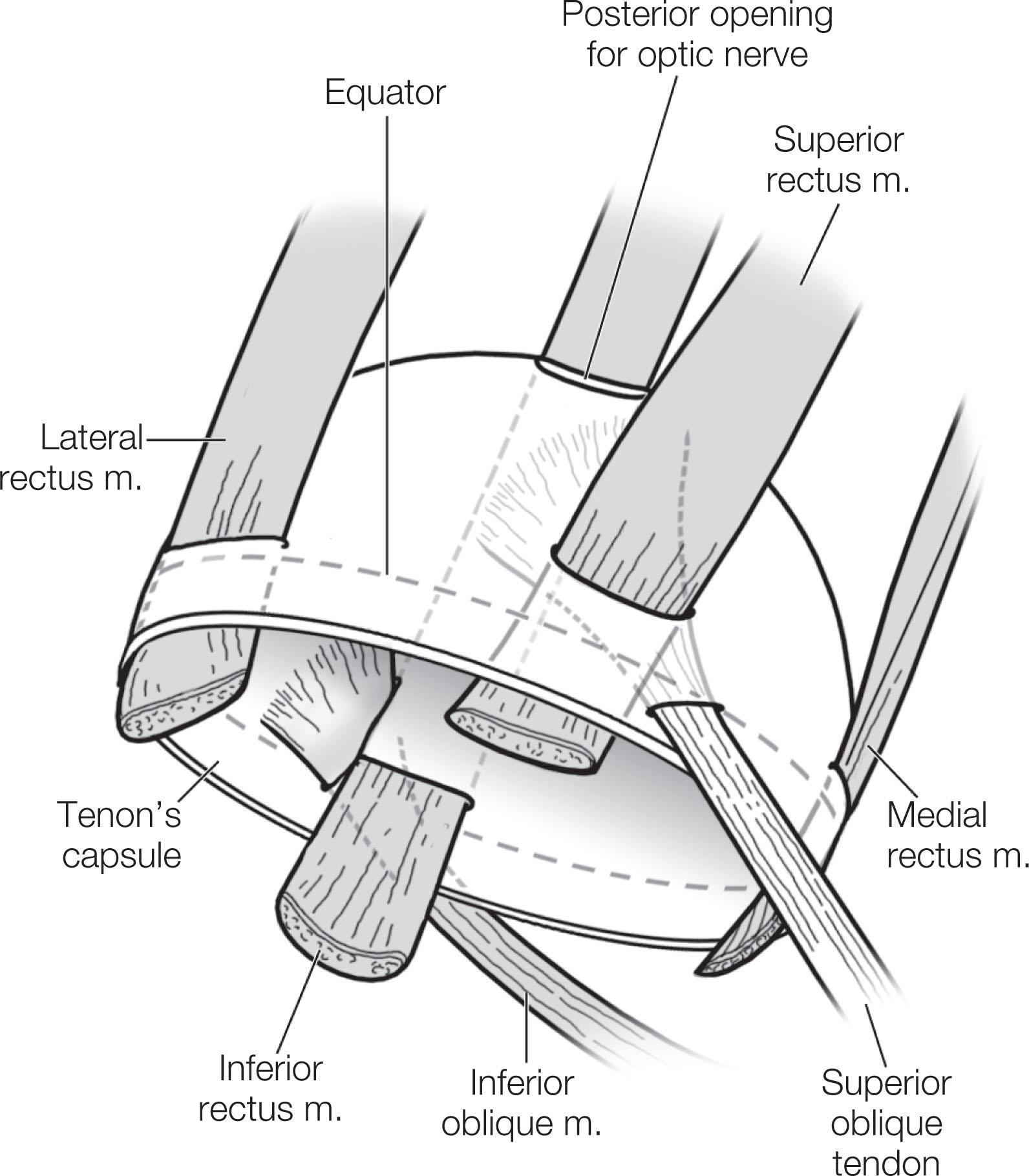
Tenon’s capsule, as with all orbital tissues, should be handled with care. Tenon’s capsule acts as a barrier to orbital fat, and a significant violation of the posterior aspects of the capsule can result in unwanted protrusion of orbital fat into the surgical space. This surgical complication can cause significant difficulties in completing planned surgery and can also lead to fat adherence and restrictive strabismus postoperatively.
The orbital aspect of the sheath of the superior rectus muscle is adherent to the internal surface of the sheath of the levator palpebral superioris muscle of the upper eyelid. The close association of these two muscles through their fascial sheaths accounts, in part, for the cooperative action seen during contraction of these two muscles, such as depression of the upper eyelid with downgaze. The surgeon must be aware of these connections because they can have important implications for the patient following strabismus surgery on the vertical rectus muscles, with resulting asymmetry of the eyelids postoperatively. The global portion of the sheath is tenuously associated with the sheath of the superior oblique tendon.
The fascial sheath surrounding the inferior rectus muscle is complex. It tends to be thicker than the fascial sheath surrounding the other rectus muscle, and this is readily apparent during surgical dissection. The global portion of this sheath fuses with and becomes continuous with Tenon's capsule, while the orbital portion contributes to the formation of Lockwood’s ligament of the lower eyelid, helping to explain why surgery on the inferior rectus muscle can alter the position of the lower eyelid.
The fascial sheath surrounding the portion of the superior oblique tendon distal to the trochlea is both strong and thick. The potential space inside of the superior oblique tendon sheath is continuous with the episcleral space. Numerous attachments extend from the sheath to adjacent structures, including attachments to the global aspect of the sheath of the superior rectus muscle and attachments to the sheath of the levator palpebrae superioris muscle of the upper eyelid. Abnormalities involving this sheath may play a role in the etiology of Brown syndrome.
The fascial sheath of the inferior oblique muscle surrounds the muscle from origin to insertion. It becomes thicker as the muscle approaches its insertion and it is usually tightly adherent to the orbital aspect of the sheath of the inferior rectus muscle. Small extensions of the sheath near the inferior oblique muscle insertion are directed to the sheath of the lateral rectus muscle and to the sheath surrounding the optic nerve posteriorly.
A reflection extending from Tenon’s capsule envelops the posterior portion of the extraocular muscles that are extrinsic to the capsule at this position in the orbit. Fibroelastic sleeves consisting of dense bands of collagen, elastin, and smooth muscle surround the rectus muscles. These sleeves are suspended from the orbit and adjacent extraocular muscle sleeves by bands of tissue having similar composition. Condensations and extensions from these muscle sheaths ultimately are also associated with anterior connections. Collectively, these structures form the rectus muscle pulley system and perform a specialized function within the orbit.
High-resolution computed tomography and magnetic resonance imaging have demonstrated that the paths of the rectus muscles remain stable relative to their adjacent orbital walls throughout most of their course in the orbit, even during eye movements and following large transposition procedures. Only the anterior aspect of the muscles actually move during normal eye movements into secondary gaze positions, while the posterior aspects of the rectus muscles are relatively fixed in position by rectus muscle pulleys, which are, in part, located near the equator of the globe. These rectus muscle pulleys essentially function as the effective origins of the rectus muscles. The pulleys are important for altering both the paths of the rectus muscles through the orbit and altering their function.
The third cranial nerve (oculomotor nerve) is the most complex of the cranial nerves supplying innervation to the extraocular muscles. It provides innervation to four of the six extraocular muscles and to the levator palpebral superioris muscle. The inferior division of the third nerve innervates the medial and inferior rectus muscles as well as the inferior oblique muscle. The superior division innervates the superior rectus muscle and levator palpebral superioris muscle. The neurovascular bundle supplying the inferior oblique muscle enters the muscle from its posterior surface near the lateral border of the inferior rectus muscle.
The superior oblique muscle is innervated by the fourth cranial nerve (trochlear nerve). It is the only extraocular muscle that receives its innervation from the external or orbital surface of the muscle. The nerve passes superiorly from the medial side of the superior oblique muscle to the orbital side of the muscle prior to entering the muscle as several small branches.
The lateral rectus muscle is innervated by the sixth cranial nerve (abducens nerve). The muscle is innervated from the internal or bulbar surface of the muscle near the junction of the anterior two-thirds and posterior one-third of the muscle.
Each of the extraocular muscles receives its blood supply from the medial and lateral muscular branches of the ophthalmic artery. The medial branch supplies the inferior and medial rectus muscles as well as the inferior oblique muscle, while the lateral branch supplies the lateral and superior rectus muscles, the superior oblique muscle, and the levator muscle. The inferior rectus and inferior oblique muscles also receive a small contribution of blood supply from other sources.
The muscular arteries of the four rectus muscles enter the muscles on their global surfaces at approximately the junction between the anterior two-thirds and posterior third of the muscle. They course anteriorly, emerging onto the orbital surface of the muscle/tendon approximately 10–12 mm from the insertions of the tendons into the sclera, where they are known as the anterior ciliary arteries ( Fig. 88.3 ). Each rectus muscle characteristically has two anterior ciliary arteries, except for the lateral rectus muscle, which characteristically has only one, though there is much variation. The course of the anterior ciliary arteries along the muscles and their tendons is highly variable. It is important to recognize this variation when planning surgery on patients who are at risk for anterior segment ischemia. The anterior ciliary vessels course forward to the episclera, where they supply branches to the sclera, limbus, and the conjunctiva. They enter the sclera near the limbus where they ultimately anastomose with the long ciliary arteries to form the major arterial circle of the iris. Veins corresponding to the muscular arteries drain into the superior and inferior orbital veins.
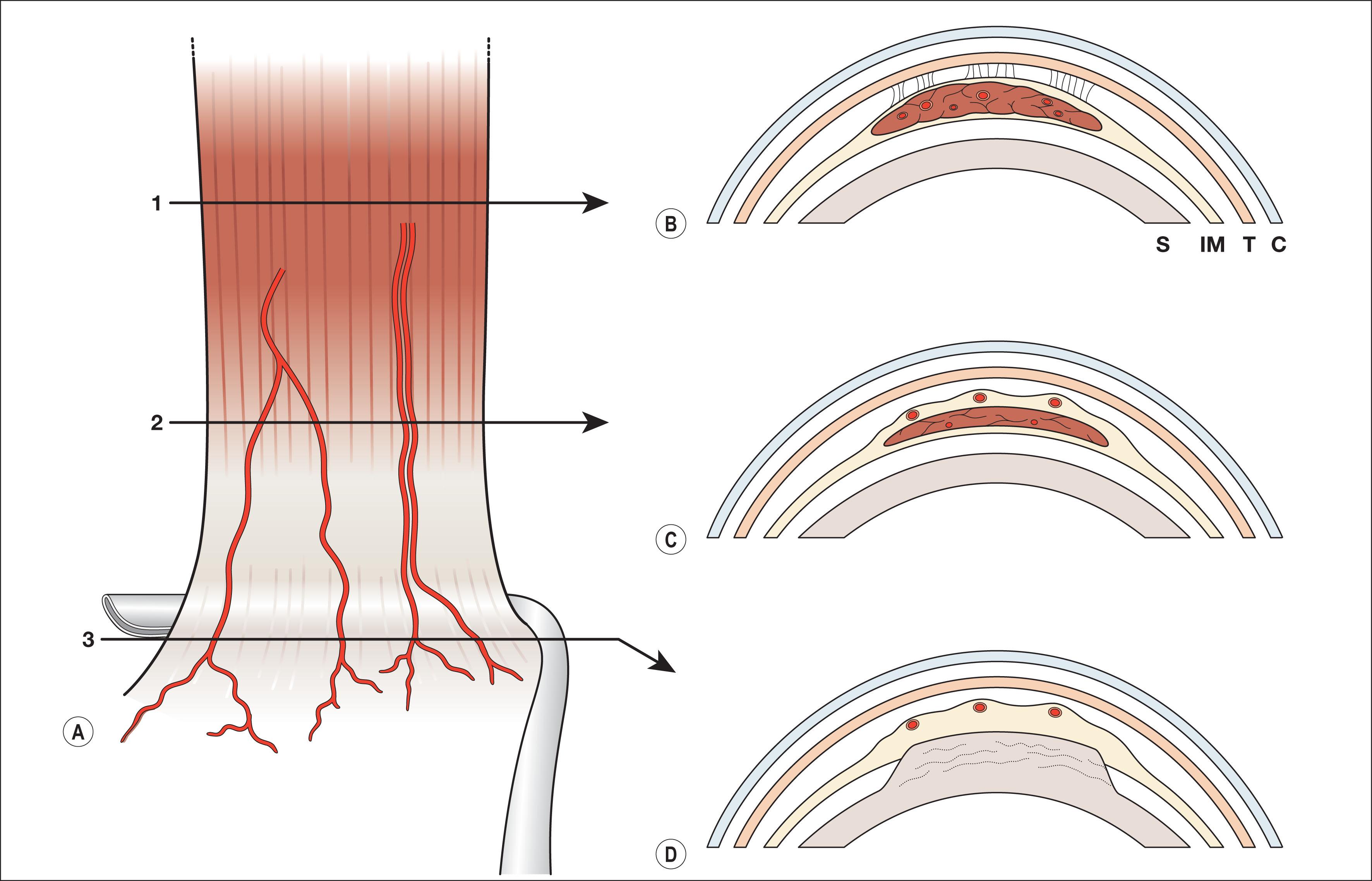
There are four striated rectus muscles arising from the annulus of Zinn in the apex of the orbit. Each is 40 mm in length and inserts on the sclera anterior to the equator of the globe. Following the “spiral of Tillaux,” the medial rectus inserts 5.5 mm from the limbus, the inferior rectus 6.5 mm, the lateral rectus 6.9 mm, and the superior rectus inserts 7.7 mm from the limbus ( Fig. 88.4 ). However, in actuality, the location of their insertions is somewhat variable. The insertions of the rectus muscles are curvilinear, particularly the vertical rectus muscles, the temporal border of which inserts further from the limbus than their nasal border.
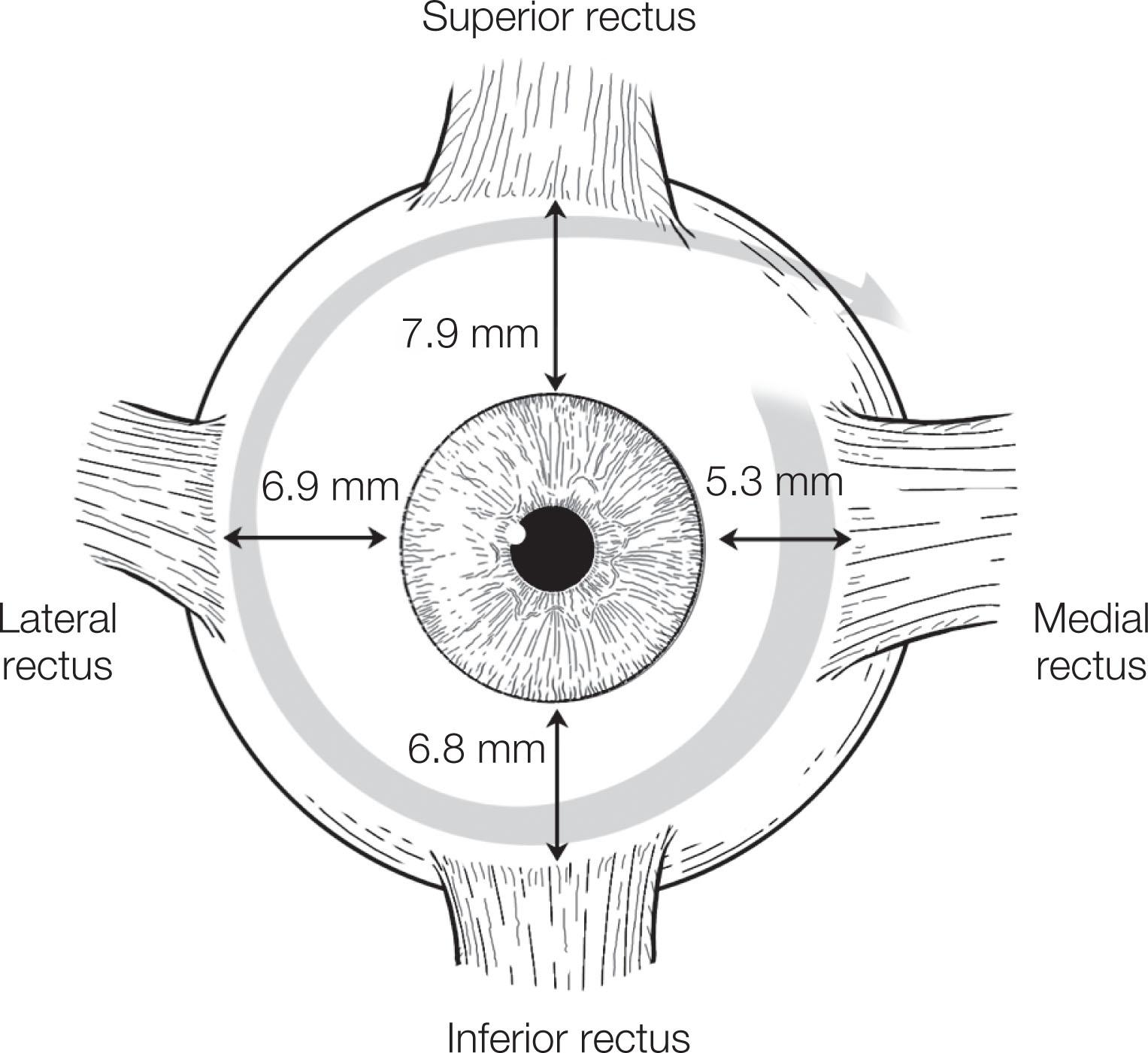
The medial rectus muscle courses anteriorly along the medial wall of the orbit, inserting on the sclera without fascial attachments to an oblique muscle. Given its innate tension and relatively short arc of contact, the medial rectus muscle is at the greatest risk of inadvertent loss during surgery.
The lateral rectus muscle courses anteriorly along the lateral orbit, inserting on the sclera with a 10 mm arc of contact with the globe. The insertion of the inferior oblique muscle is in close proximity to the lower border of the lateral rectus muscle, 8–10 mm posterior to the lower pole of the lateral rectus muscle insertion ( Fig. 88.5 ). Because of the close proximity of its insertion to the lateral rectus muscle, the inferior oblique muscle is often inadvertently hooked along with the lateral rectus muscle when isolation of the lateral rectus muscle is attempted during surgery. This complication is more likely to occur when the lateral rectus muscle has been previously recessed. Failure to recognize that the inferior oblique muscle has been inadvertently hooked can result in a significant postoperative motility disturbance that is restrictive in nature. The fascial attachments between the lateral rectus and the inferior oblique muscle help to locate the lateral rectus muscle if it becomes detached during surgery or trauma.
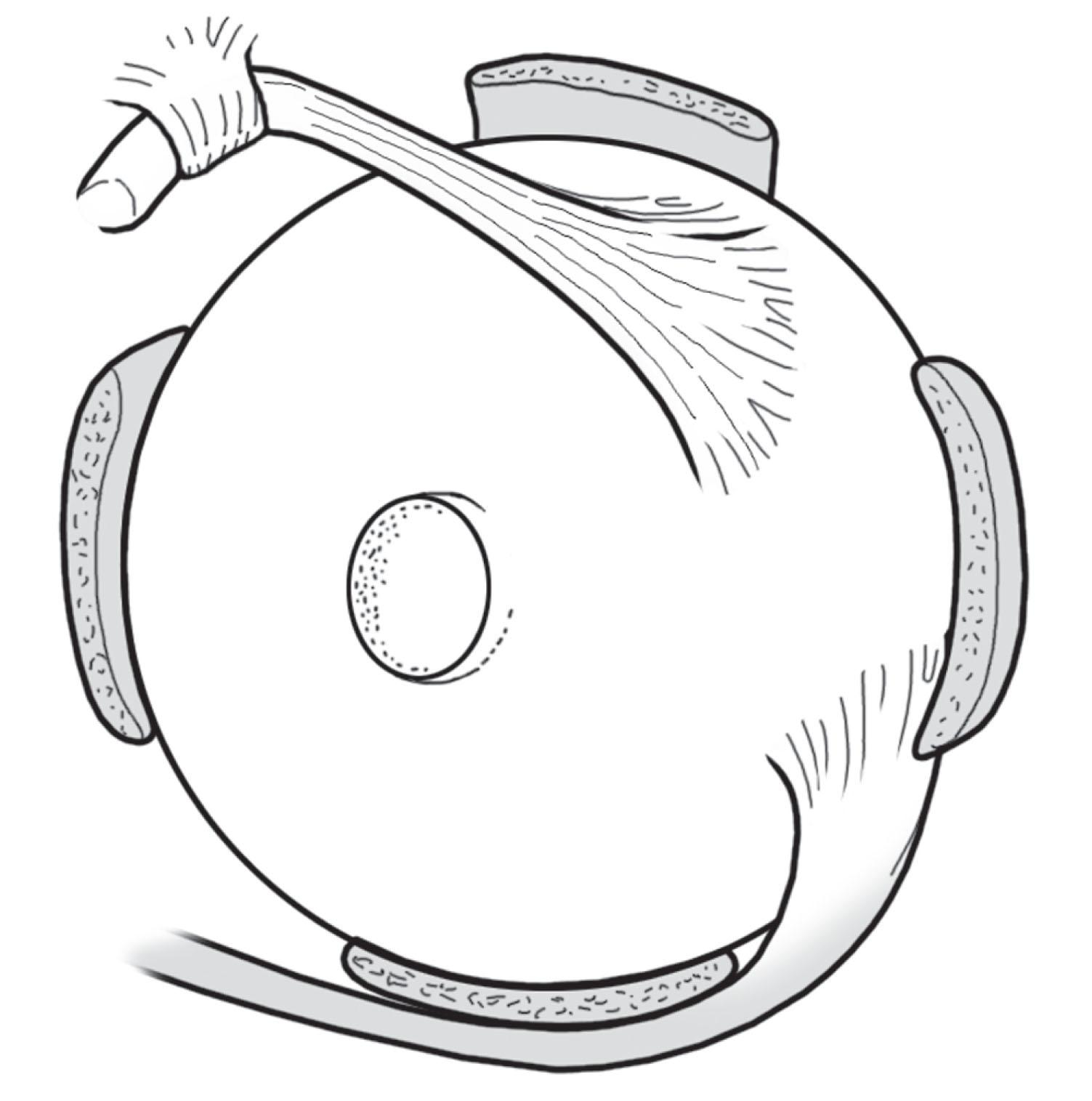
The inferior rectus muscle courses anteriorly, laterally, and inferiorly to insert on the sclera. It inserts an average of 6.8 mm posterior to the limbus. The temporal border of the tendon inserts approximately 2 mm more posteriorly than the nasal border of the insertion, a fact that should be considered when recessing or resecting the muscle. When hooking the inferior rectus muscle, the surgeon should avoid passing the hook too deeply into the orbit. A vortex vein can typically be seen posteriorly near both the medial and lateral borders of the inferior rectus muscle ( Fig. 88.6 ). Disturbance of a vortex vein can result in considerable bleeding; continuation of surgery after disruption of a vortex vein can be difficult. The inferior rectus muscle forms a 23 degree angle with the visual axis when the globe is in the primary gaze position. It has fascial attachments to the inferior oblique muscle and the lower eyelid retractors. If these attachments are not severed during a large recession or resection of the inferior rectus muscle, eyelid fissure position changes may occur. Connective tissue attachments between the inferior rectus and the inferior oblique muscles may assist the surgeon in locating a “lost” inferior rectus muscle.
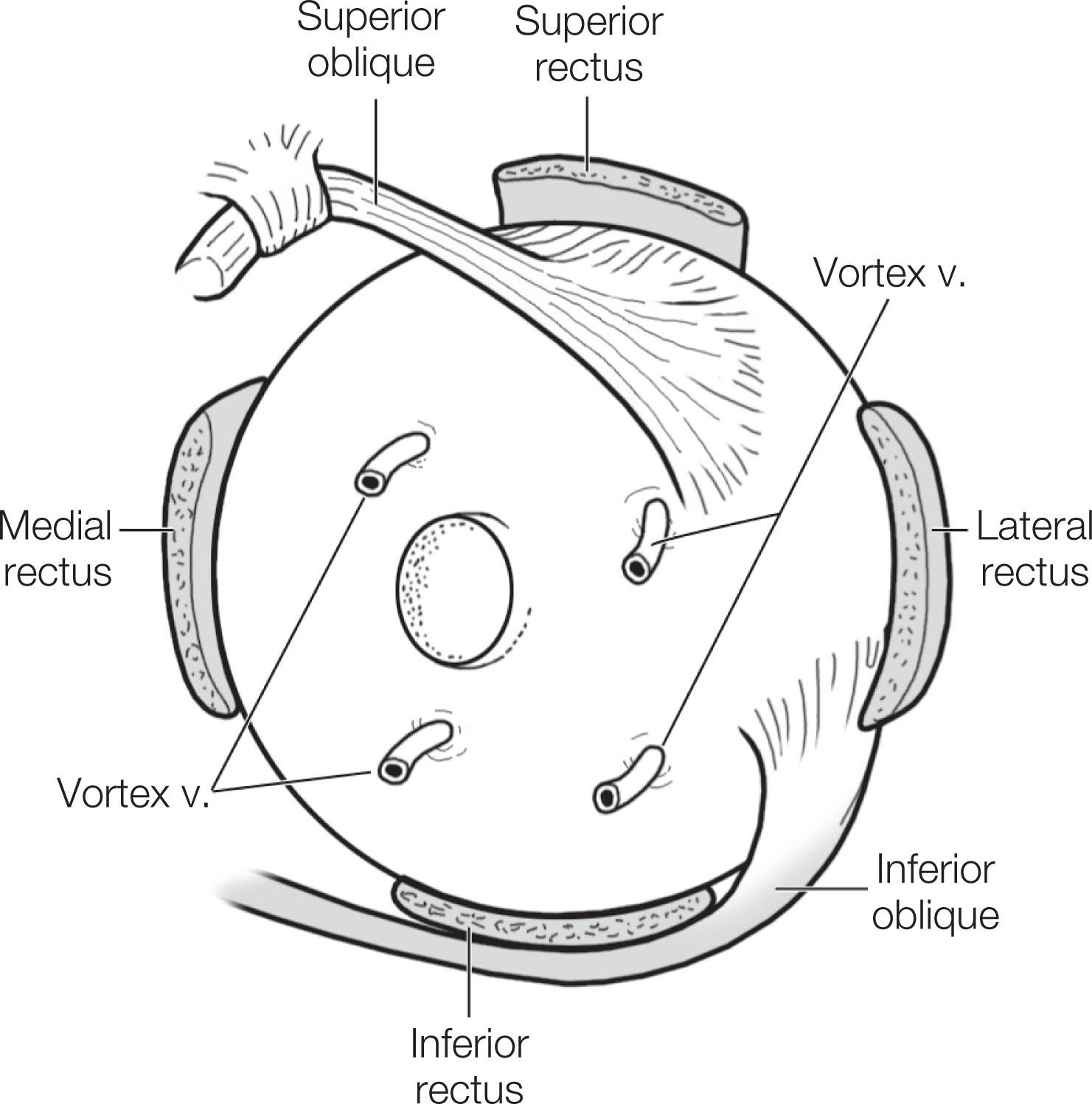
The superior rectus muscle courses anteriorly, laterally, and superiorly to insert on the sclera. The temporal border of the tendon inserts almost 3 mm more posteriorly than the nasal border. It is the only rectus muscle that inserts posterior to the ora serrata. As such, perforation of the eye wall near the insertion of the superior rectus muscle may involve the retina. A vortex vein can usually be found posteriorly near the border of the superior rectus muscle nasally and temporally (see Fig. 88.6 ). Vortex veins are infrequently damaged during surgery on the superior rectus muscle. Compared to the inferiorly located vortex veins, it is more difficult to inadvertently hook or otherwise manipulate the vortex veins when attempting to isolate the superior rectus muscle. The superior rectus muscle forms a 23 degree angle with the visual axis when the globe is in the primary gaze position. The global aspect of the superior rectus muscle sheath is attached to the superior oblique tendon through relatively tenuous connections ( Fig. 88.7 ). If the close relationship between these two structures is not recognized, the superior oblique tendon can sometimes be inadvertently hooked, along with superior rectus muscle tendon. If unrecognized, the superior oblique tendon may be recessed or resected along with the superior rectus muscle, producing unexpected torsional and vertical misalignment. The superior rectus muscle also has fascial attachments to the levator palpebrae muscle. If the attachments to the levator palpebrae muscle are not divided during recession or resection of the superior rectus muscle, eyelid fissure changes may occur.
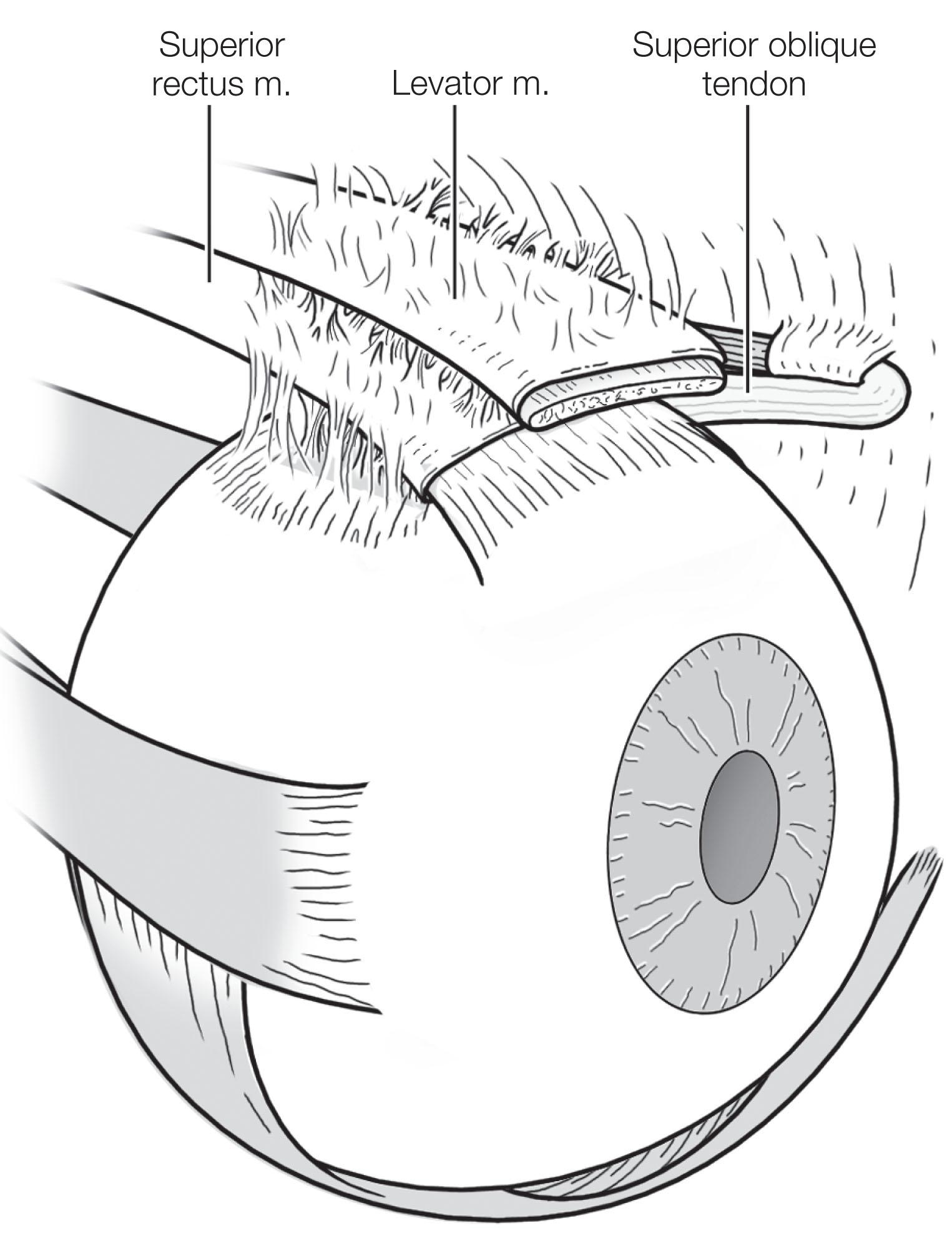
The actions of the superior oblique muscle are incyclotorsion, depression, and abduction. The superior oblique muscle arises from the periosteum in the orbital apex above the annulus of Zinn and travels anteriorly along the superomedial orbital wall. It becomes a cord-like tendon, passing through the trochlea to run in a posterolateral direction at an angle of approximately 51–54 degrees with the sagittal plane. The tendon passes under the superior rectus muscle and fans out, inserting on the sclera in the superotemporal quadrant. The anterior pole of its insertion is located close to the lateral border of the superior rectus muscle, beginning 4–6 mm posterior to the superior rectus insertion. Its tendon is thin and broad, extending posteriorly for about 11 mm, but with considerable variability. The posterior end of the insertion lies 6−7 mm from the optic nerve. The superior temporal vortex vein may exit the sclera temporal to the superior oblique insertion, under the insertion of the tendon or occasionally may split the fibers of the insertion and pass through them (see Fig. 88.6 ).
The actions of the inferior oblique muscle are excyclotorsion, elevation, and abduction. The inferior oblique muscle forms an antagonist pair with the superior oblique muscle with respect to torsion.
The inferior oblique muscle originates from the maxillary bone adjacent to the lacrimal fossa. It passes posteriorly and laterally, forming approximately a 51 degree angle with the sagittal plane. After passing beneath the inferior rectus muscle, the inferior oblique muscle travels upward, inserting on the sclera, close to the macula. The tendon of the inferior oblique muscle is 1−2 mm long, the shortest of the extraocular muscle tendons. The anterior aspect of the inferior oblique muscle insertion is 8–12 mm posterior to the lateral rectus insertion, adjacent to its lower border. There is considerable variability in the location and configuration of the inferior oblique muscle insertion.
The inferior temporal vortex vein lies close to the posterior border of the inferior oblique muscle (see Fig. 88.6 ). The vein can be damaged when the surgeon isolates the inferior oblique muscle, or when repositioning an inferior oblique muscle near the sclera exit of the vortex vein during the process of recession.
The neurovascular bundle enters the inferior oblique muscle as it passes beneath the inferior rectus muscle. The neurovascular bundle may serve as the effective origin of the inferior oblique muscle, particularly after anterior transposition of the muscle.
Most strabismus surgery is performed in an outpatient setting. The type of anesthesia depends upon one or more of the following factors: patient preference, surgeon preferences, nature of the operation planned, health of the patient, and the recommendations of the anesthesiologist. No single anesthesia modality universally applies to all patients in all situations. Options include general, local, and even topical anesthesia. Children, and most young adults, require general anesthesia because they usually are unable to tolerate surgical manipulation under local anesthesia.
Safe and effective strabismus surgery begins even before the patient enters the operating room. The patient, and/or parents, should understand the risks, benefits, and alternatives of the proposed operation as well as have realistic expectations for the surgery. Ideally, this conversation will have occurred prior to surgery and will be documented in the medical record. A surgical consent that properly documents these issues should also be signed and placed into the record. The laterality of the procedure should be recorded and the skin adjacent to the operated eye marked per universal protocol. Once the patient is brought into the operating suite, all parties in the room should perform a “time-out” and agree upon the planned procedure and other important details. The patient is then prepared for the operation.
Many strabismus surgeons instill one drop of 2.5% phenylephrine in the operated eye(s) prior to the surgical preparation to provide vasoconstriction and dilate the pupil should postoperative fundoscopy be needed. Alternatively, brimonidine 0.1% may be used. This causes effective conjunctival vasoconstriction without pupillary dilation. The patient’s skin, lid margins, and conjunctiva are the most common source of bacterial contamination and cleansing of these structures with an antimicrobial solution prior to surgery is among the most important ways to reduce the risk of postoperative infection. Skin preparation can be accomplished with 5%–10% povidone-iodine solution. Irrigation of the conjunctiva with half strength (5%) povidone-iodine solution prior to surgery has been shown to be effective in reducing conjunctival bacterial flora. Draping should sufficiently overlap the cleansed area of the skin. The eyelashes can be covered with an adhesive drape if desired. Markings made on the skin preoperatively to identify the surgical site should be visible after the drapes have been placed ( Fig. 88.8 ).
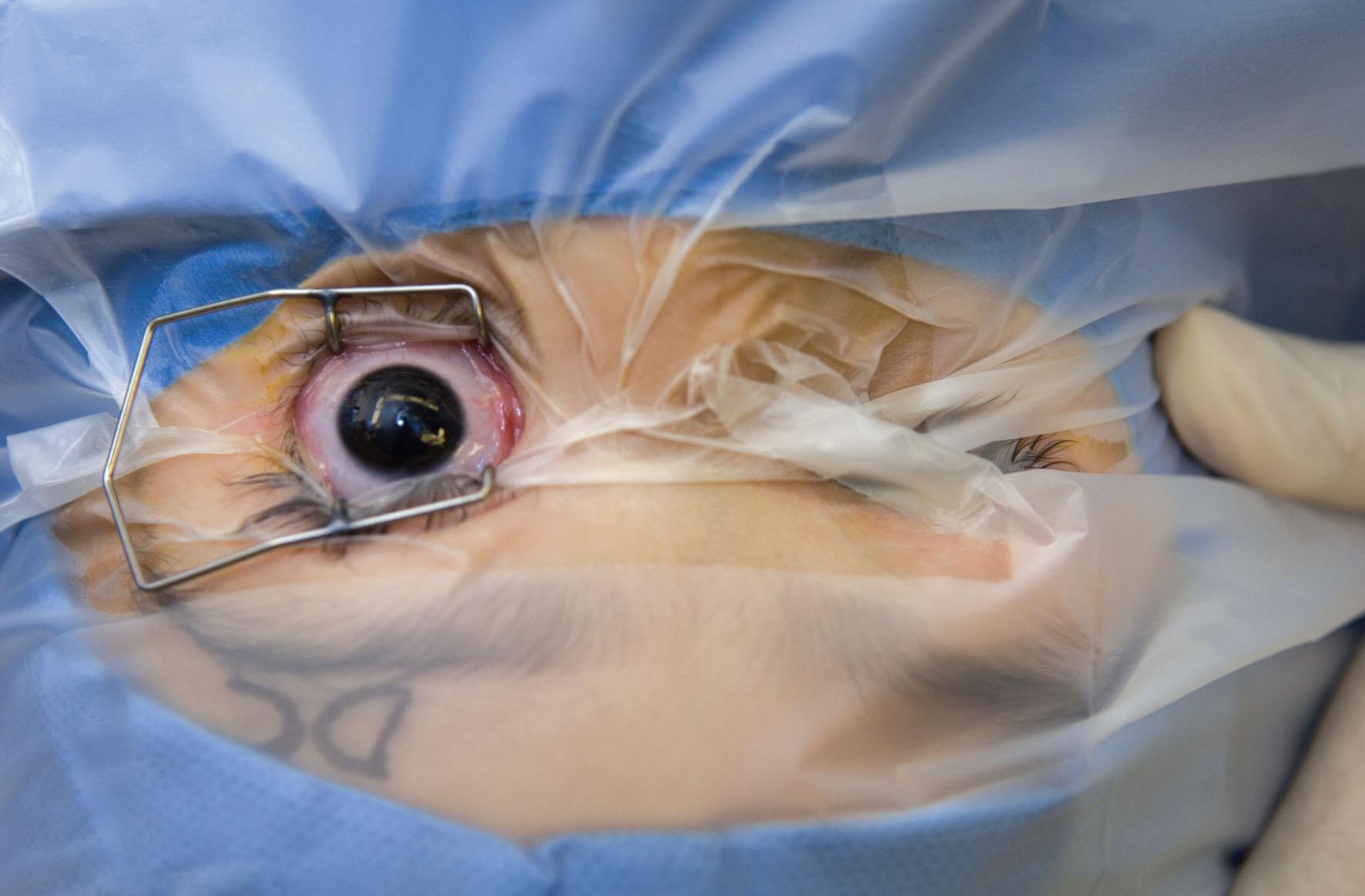
While there is a wide variety of instruments of various shapes and sizes available for strabismus surgery, the reality is that strabismus surgery can usually be performed very well with a set of basic instruments as shown in Fig. 88.9 . Many surgeons find 0.5 locking forceps and grooved muscle hooks to be particularly valuable in facilitating strabismus surgery.
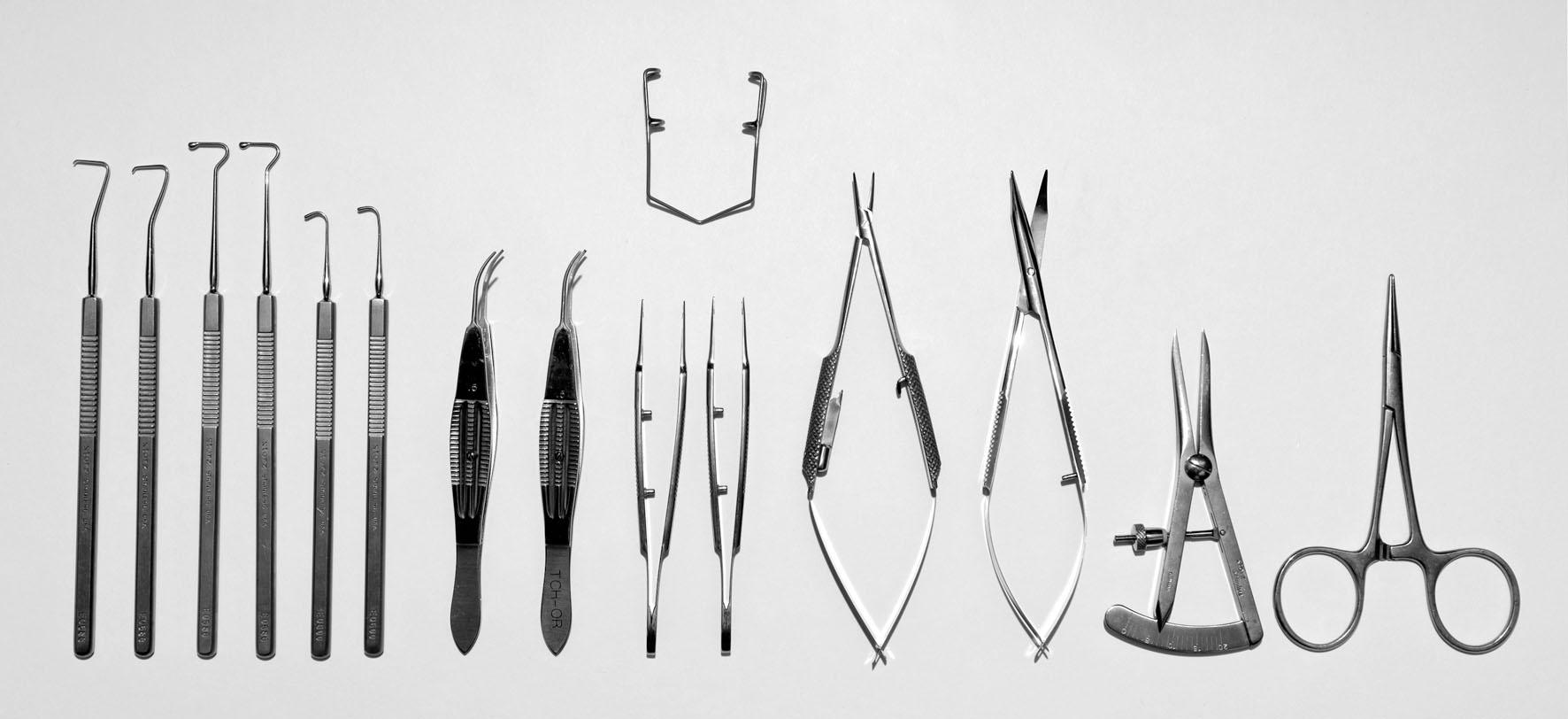
Sutures used for strabismus surgery should generally be bioabsorbable, though not all surgeons agree. Polyglactin 910 (Vicryl®, Ethicon, Somerville, NJ) is one commonly used bioabsorbable synthetic suture. Two polyglycolic-based sutures that have been used for strabismus surgery are Biosorb™ C (Alcon, Fort Worth, TX) and Dexon™ S (Covidien/Medtronic, Dublin, Ireland). Non-absorbable suture, such as polyester fiber suture (Mersilene®, Ethicon, Somerville, NJ) is often used for procedures where a permanent suture is desired.
Spatulated needles are preferred for making scleral passes during strabismus surgery because they facilitate keeping the needle in the surgical plane, thereby reducing the risk of scleral perforation. The features of four commonly used spatulated needles are highlighted in Table 88.1 . A collagen suture, such as 6.0 plain gut suture, is a good choice for closing the conjunctiva. These come in a variety of needles, the choice of which is based on surgeon preference.
| Type of needle | S14 | S24 | S28 | TG 100 |
|---|---|---|---|---|
| Cross-section |  |
 |
 |
 |
| Point of needle | Top | Top | Bottom | Top |
| Curvature (degrees) | 112 | 90 | 164 | 97 |
| Chord length (mm) | 7.23 | 7.31 | 5.28 | 5.94 |
| Radius (mm) | 4.37 | 5.16 | 2.67 | 3.96 |
| Thickness (mm) | 0.33 | 0.33 | 0.2 | 0.2 |
The type of magnification, and even the choice of using or not using magnification during strabismus surgery, is based upon the personal preference of the surgeon. When magnification is desired, it can be accomplished through the use of a surgical microscope or through the use of surgical loupes.
All strabismus surgery requires an incision through the conjunctiva and through Tenon’s fascia to gain access to the episcleral space, and all standard surgical manipulation of the extraocular muscles and associated structures occurs in this space. The two most commonly used incisions are the fornix and the limbal approaches. Small incisions placed near the muscle insertion in a technique referred to as minimally invasive strabismus surgery (MISS) has been adopted by some surgeons. Each surgical approach has a set of advantages and disadvantages.
The fornix conjunctival incision approach to strabismus surgery was popularized by Parks and has undergone modifications by several surgeons. A fornix conjunctival incision can be made in any of the oblique quadrants between adjacent rectus muscles ( Fig. 88.10 ). Incisions in the inferior quadrants are preferable, when possible. The incision is made approximately parallel to the lid margins, 8–10 mm posterior to the limbus. The precise location and orientation of a fornix incision depends on a number of factors, including which muscle(s) is to be operated on, surgeon preference, the type of surgery (recession vs. resection), size of the recession, presence of other ocular pathology, and previous surgery.
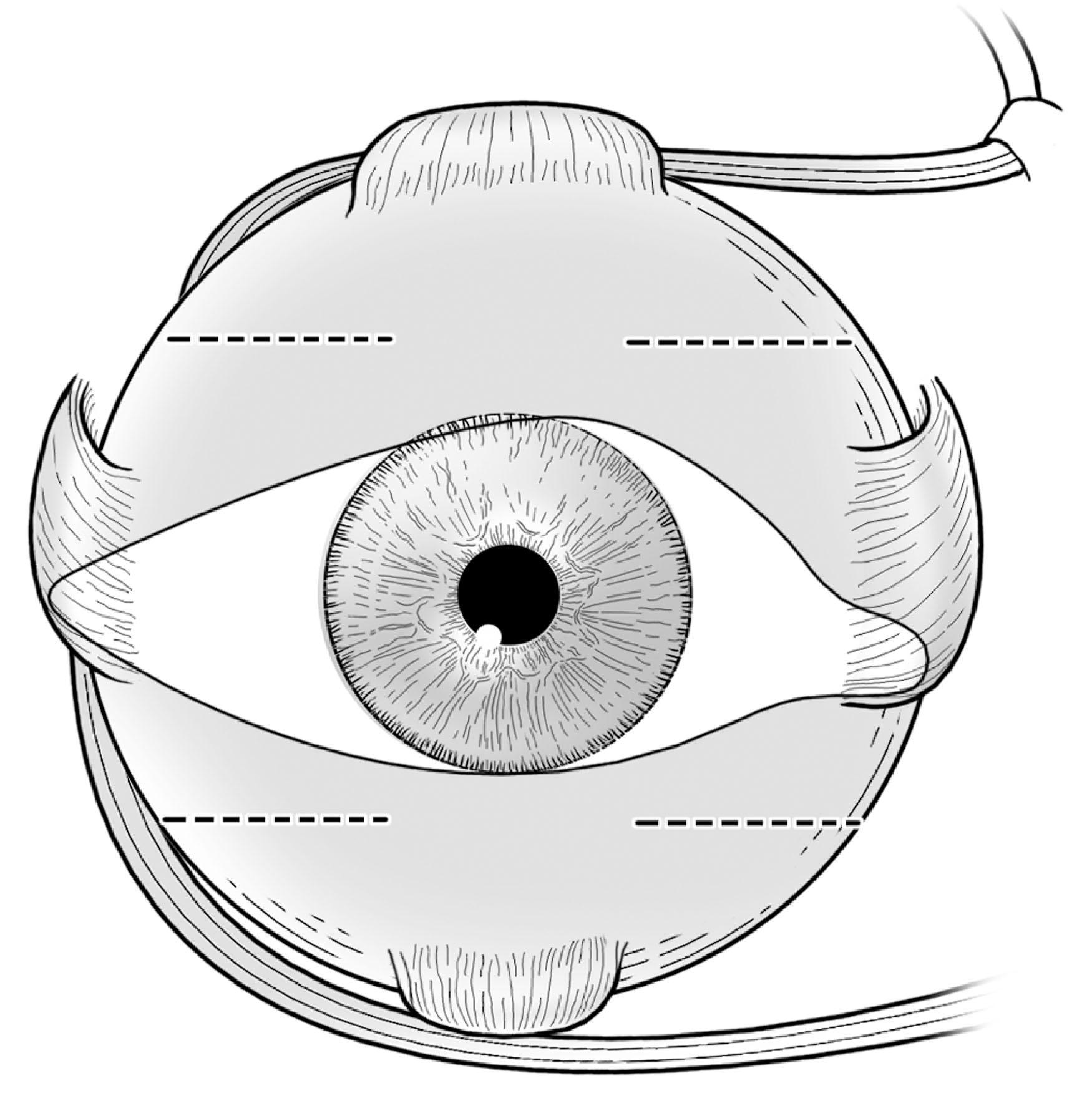
The globe is rotated to expose the incision site. The conjunctiva is grasped with a fine-tipped forcep, placed under mild anterior traction, and a 6–8 mm incision is made ( Fig. 88.11A ). Tenon’s fascia is then incised to gain access to the episcleral space ( Fig. 88.11B ). A hook is passed through the incision into the episcleral space and is advanced to isolate the rectus muscle insertion ( Fig. 88.12 ). Many surgeons pass a second hook to assure that the entire width of the muscle has been isolated. A small muscle hook is used to retract the conjunctiva over the muscle insertion ( Fig. 88.13A ). The intermuscular septum, now visible, is placed under tension and incised to expose the toe of the muscle hook and underlying bare sclera ( Fig. 88.13B ). The toe of the small hook is placed on bare sclera located behind the muscle insertion. While maintaining contact on the globe, the hook is slowly moved around the muscle insertion to assure that the full width of the muscle insertion has been isolated. The muscle insertion is then exposed by dissection of the muscle capsule and intramuscular septum. The amount of dissection required is dependent upon the procedure planned and the personal preference of the surgeon ( Fig. 88.14 ). After completion of surgery, the incision can be closed with bioabsorbable suture, or the edges of the incision can be re-approximated without suture closure. This is largely a matter of surgeon preference.
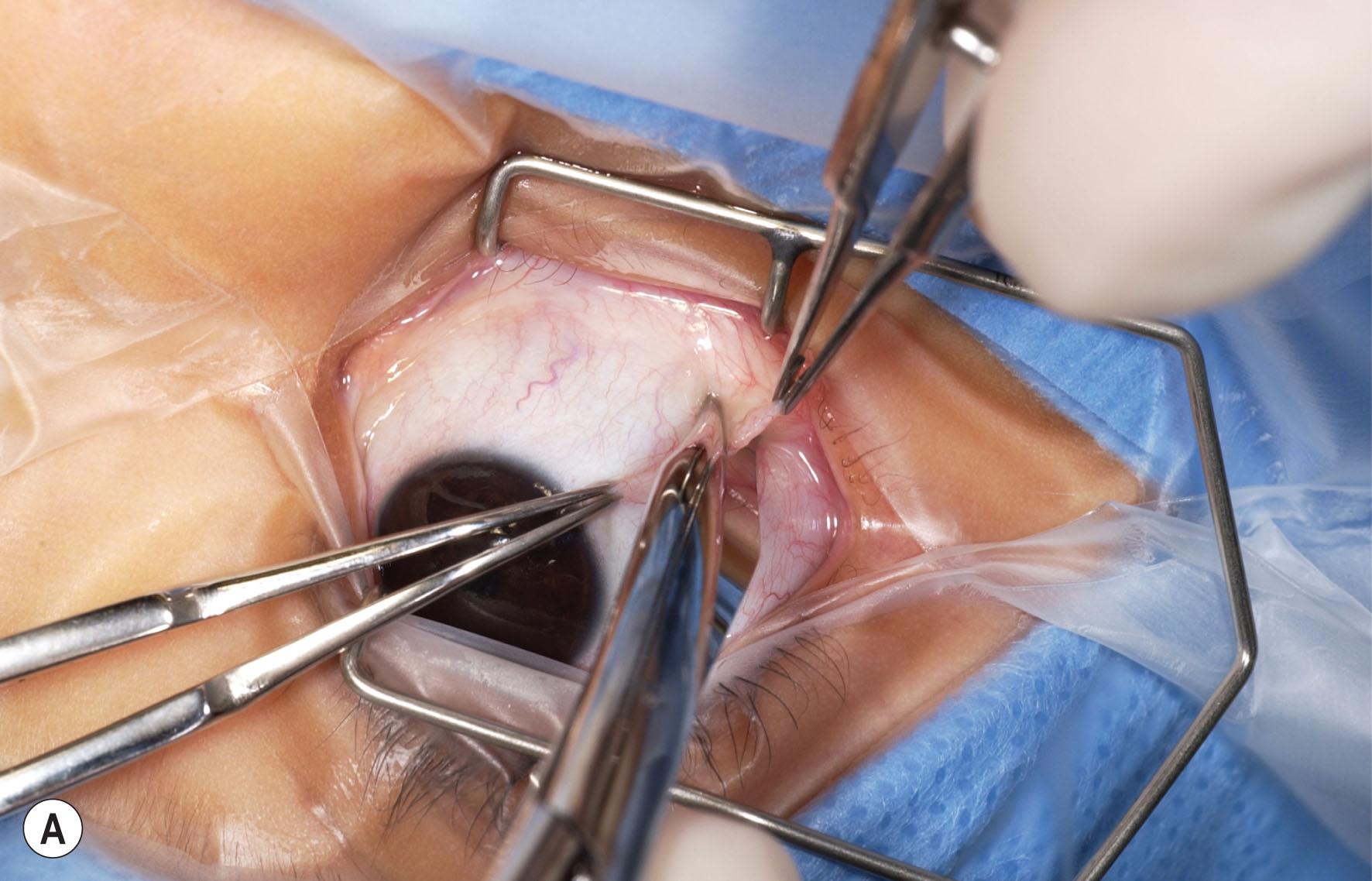
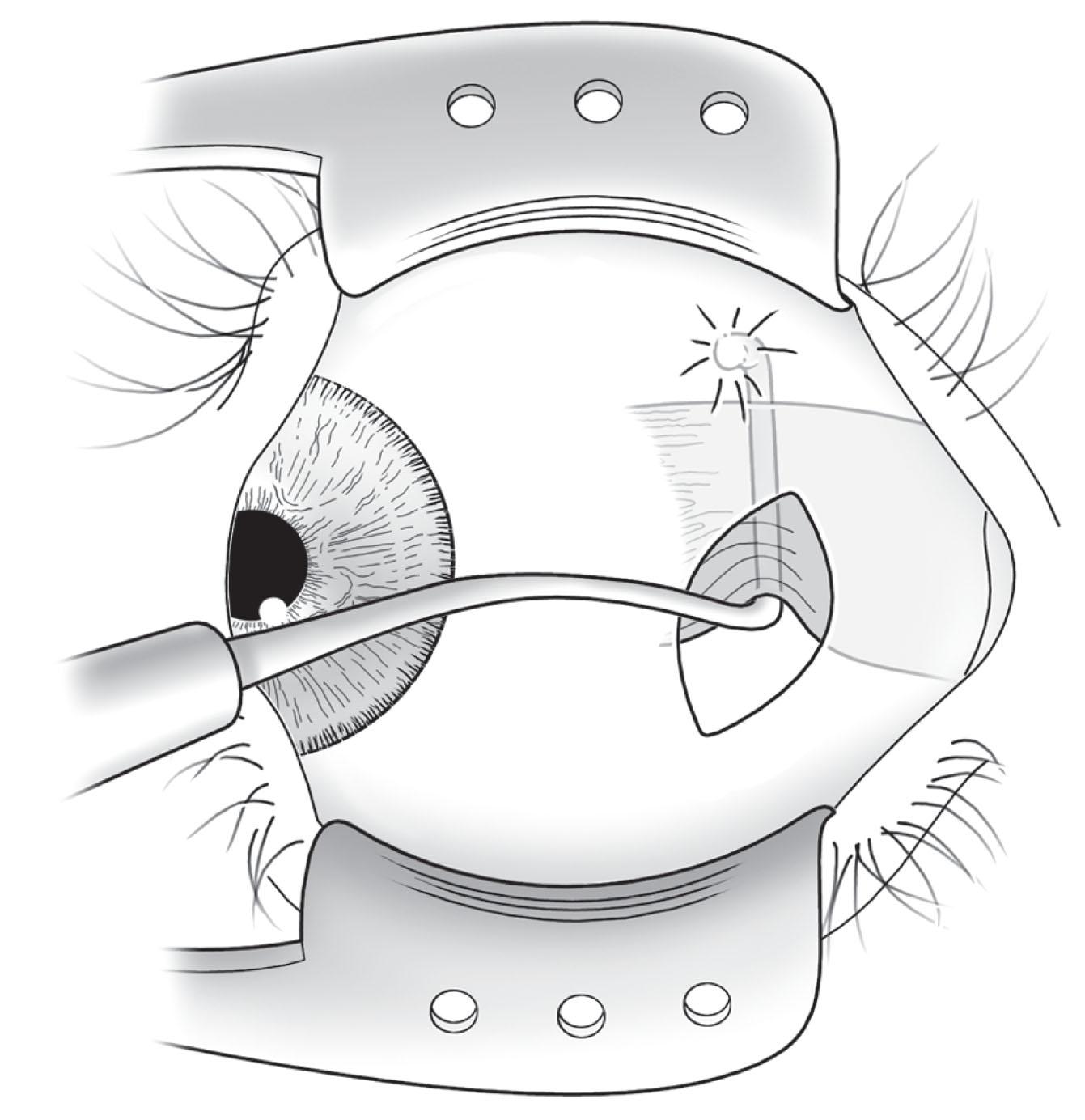
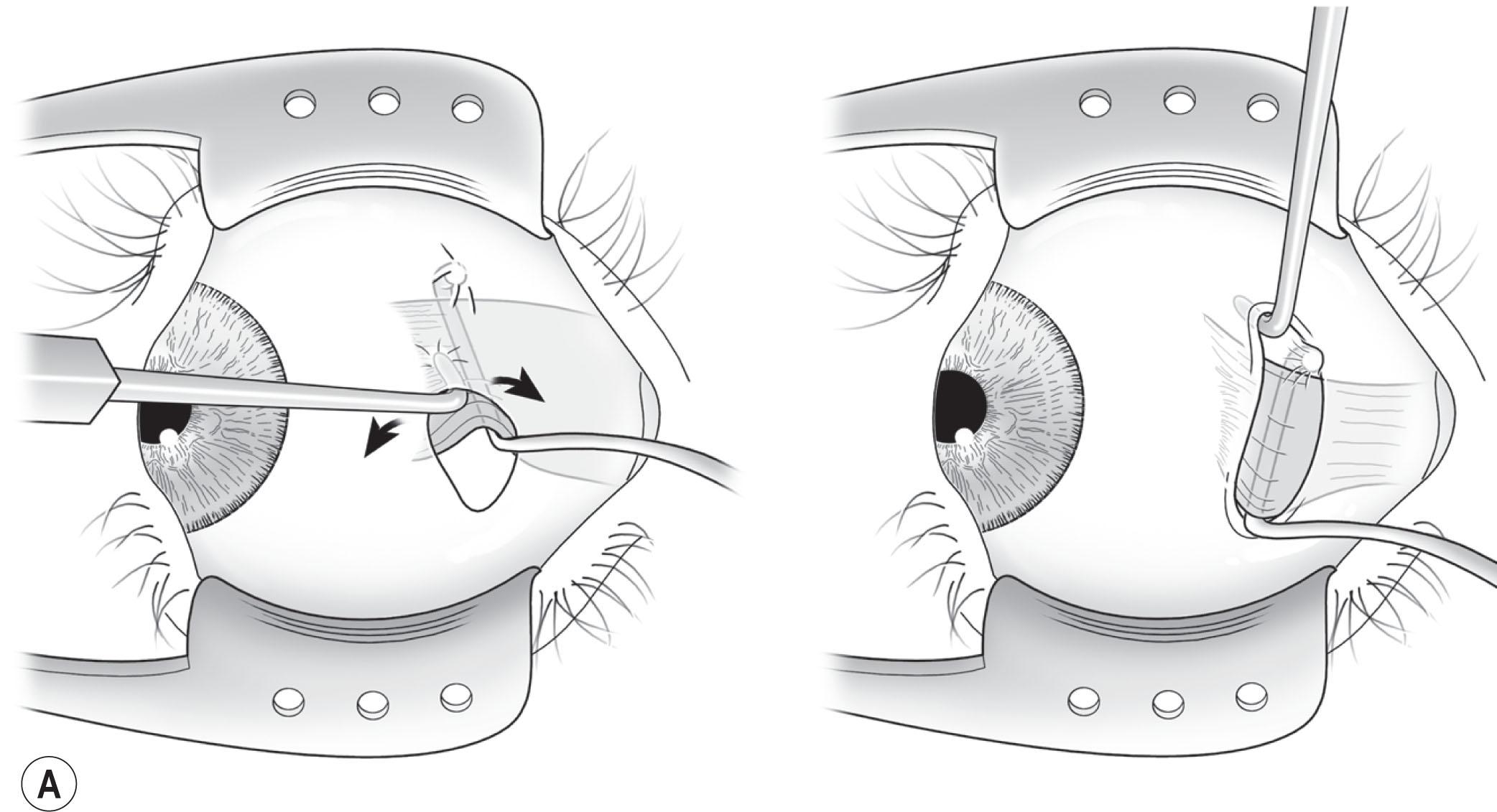
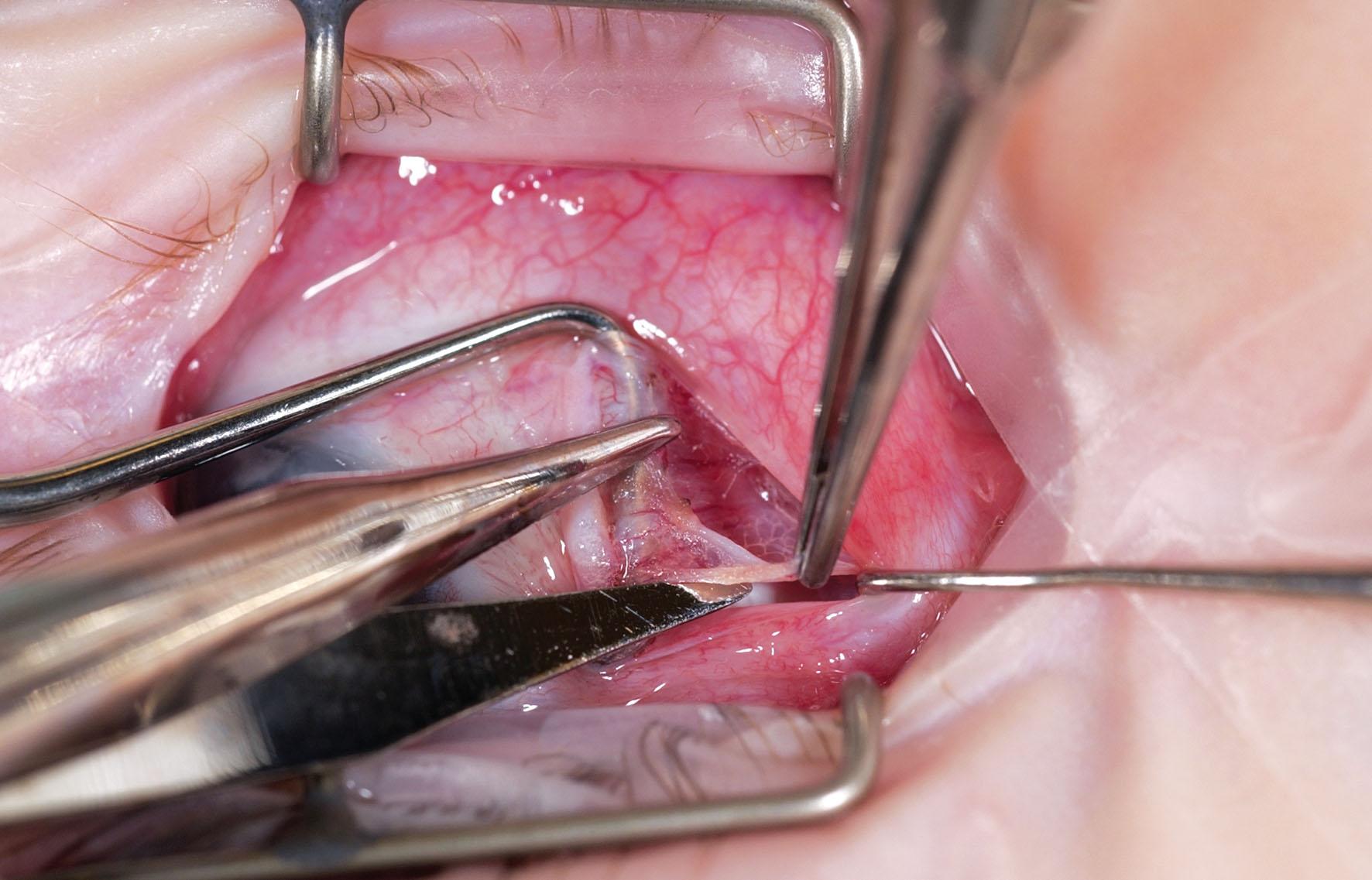
The limbal approach to strabismus surgery was popularized by von Noorden. Many surgeons prefer limbal incisions because they are universally applicable to any and all rectus muscle operations. The limbal approach to strabismus surgery involves creation of a conjunctival flap that is initiated at the limbus and has its base in the fornix. The incision typically involves 2–3 clock hours of conjunctiva adjacent to the corneal limbus, with radial incisions that are 8–10 mm in length into adjacent oblique conjunctival quadrants between adjacent rectus muscles. Placement of limbal incisions for surgery on each of the rectus muscles is shown in Fig. 88.15 .
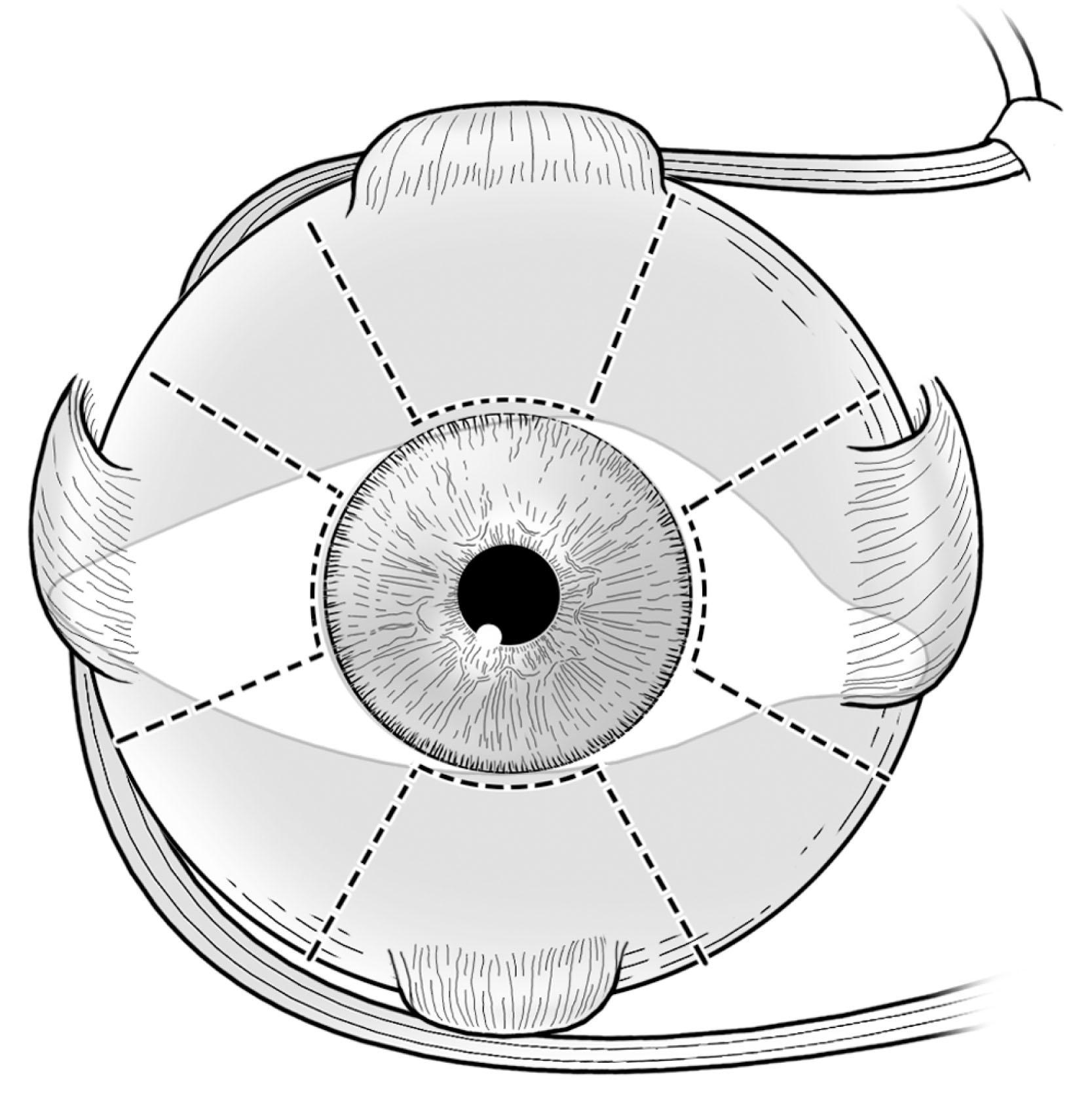
The conjunctiva incision is created using sharp dissection ( Fig. 88.16A,B ). The intermuscular septum is opened with blunt dissection on one or both sides of the muscle, adjacent to the muscle border ( Fig. 88.17A ). The muscle insertion is then isolated on a muscle hook, under direct visualization ( Fig. 88.17B ). The muscle capsule and intermuscular septum are then dissected to expose the rectus muscle ( Fig. 88.17C ). The amount of dissection of these structures depends on the preference of the surgeon and the procedure being performed. The incision is closed at the conclusion of surgery by placing a bioabsorbable suture at each edge of the conjunctival flap and suturing it to the adjacent intact conjunctiva. Additional sutures to close the radial relaxing incisions are permissible, but not required.
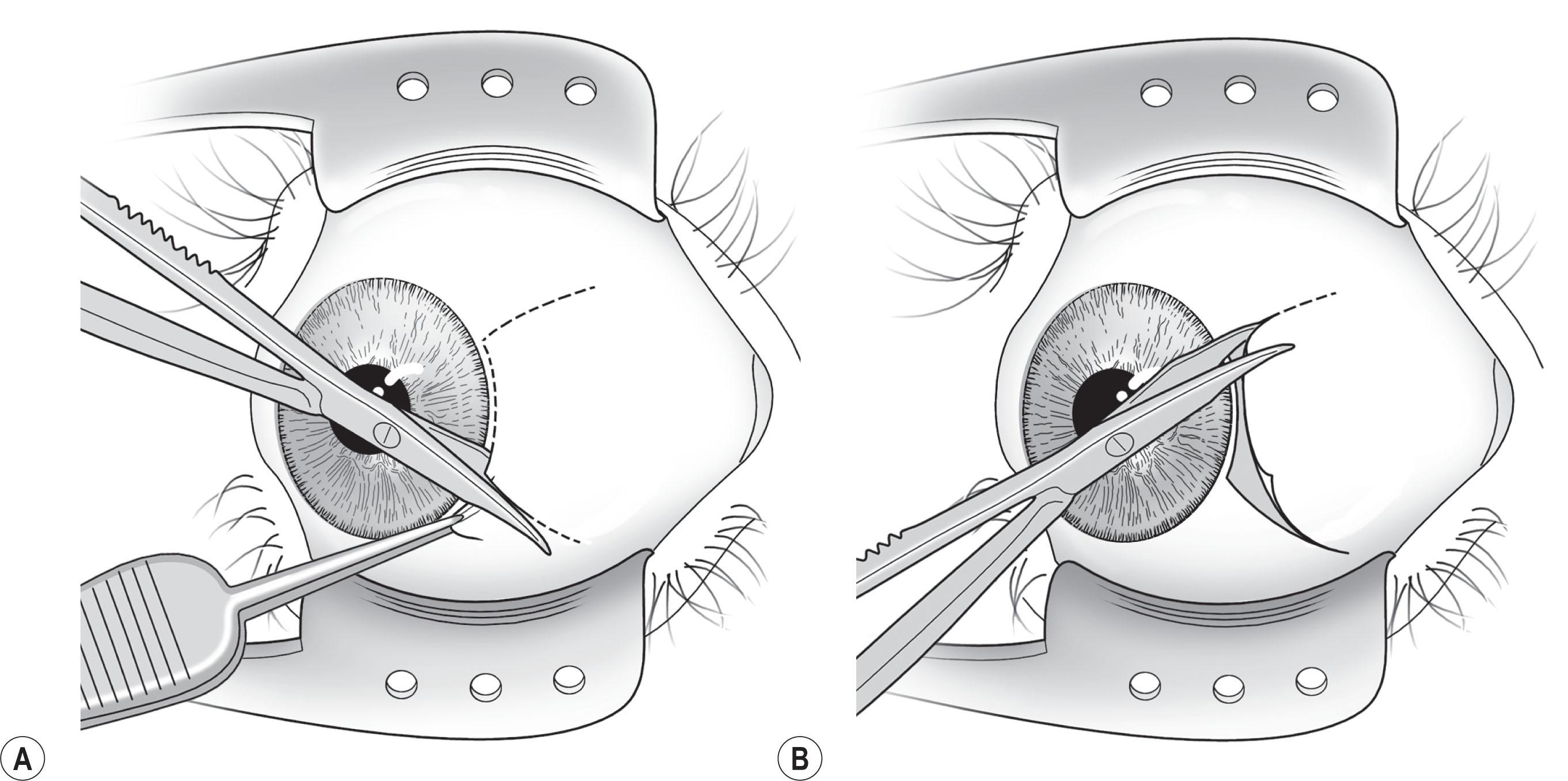
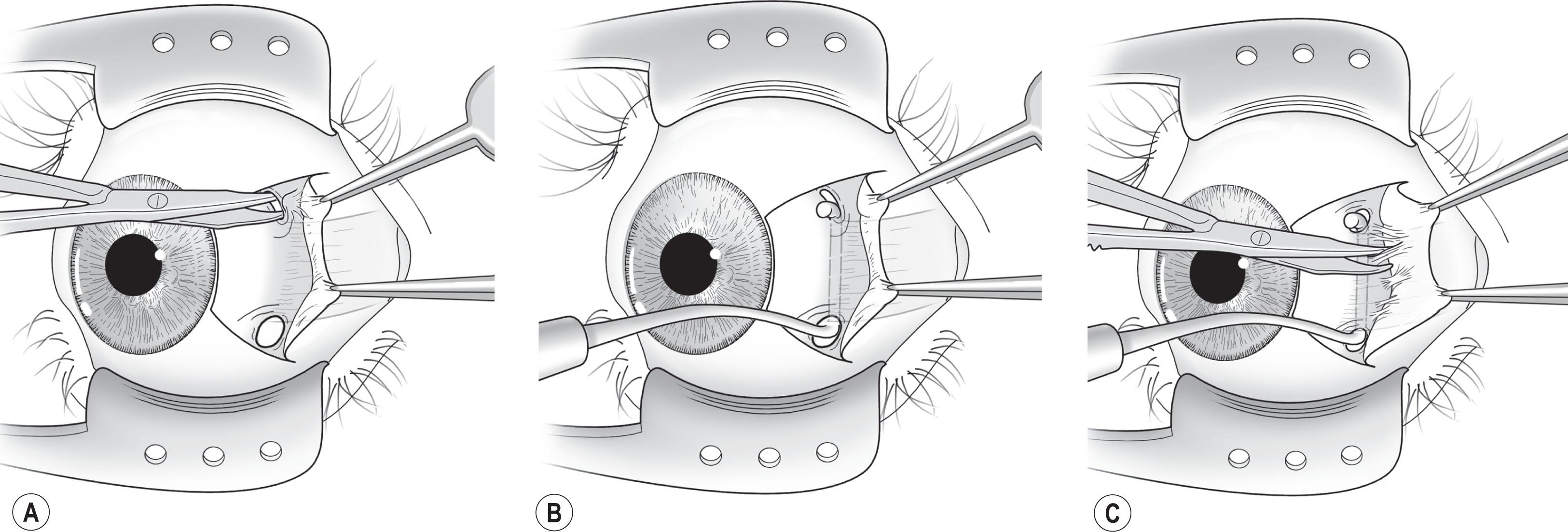
Surgery on the oblique muscles is generally performed through a fornix incision. The incision is created in a manner similar or identical to that described above. Oblique muscles can also be approached through a limbal incision. Techniques to isolate the oblique muscles will be described in later sections.
By moving a rectus muscle posterior to its original insertion site and re-attaching it to the sclera, the length/tension curve of the muscle is altered. This has the effect of “weakening” the muscle’s effect on the globe. For most recessions, this effect is seen clinically only as a change in the alignment of the eye. Ocular ductions are not clinically limited unless a very large recession is performed, typically involving placement of the muscle posterior to the equator. This weakening effect probably occurs both because of a reduction in the distance between the origin and new insertion of the muscle, and because of changes in the relationship between Tenon’s capsule, the intermuscular septum, and the rectus muscle pulley system. The relationship between the amount of recession required and the size of the deviation treated is not linear. As can be seen in Table 88.2 , the effect obtained from recessing the medial rectus muscle is initially linear, but as the size of the recession increases, the relative effect of the procedure increases. Once the muscle is placed behind the equator, the incremental effect of further recession will then be reduced.
| Deviation (PD) | Recession from the original insertion |
|---|---|
| 15 | 3 mm |
| 25 | 4 mm |
| 35 | 5 mm |
| 50 | 6 mm |
| 70 | 7 mm |
The “safe” limit for a recession depends on the condition being treated. In the mid-20th century, it was believed that the medial rectus muscle could not be recessed more than 5.0 mm without significantly interfering with movement of the eye. This belief resulted in many cases of congenital esotropia being undertreated. In an effort to improve the success rate of surgery, three or four muscles often were operated on at one time. It was later recognized that medial rectus recession of at least 7 mm could be performed without producing an adduction deficit. This led to a higher surgical success rate, particularly for larger deviations, while avoiding the need to operate on additional muscles. Some studies have shown that even larger recessions can be performed on the medial rectus muscle without creating a duction deficit. It may be necessary to accept a postoperative duction limitation for treatment of some conditions. For example, a patient with a large exotropia in a poorly seeing eye will usually gladly tolerate the requisite abduction deficit that will occur after a large recess-and-resect operation in order to avoid the need to operate on the “sound eye.” The notion that there is a “maximum” amount of rectus muscle recession should be avoided.
Recessions can be performed by attaching the muscle to the sclera at the desired position or by employing “hang-back,” “hemi hang-back” recession, or various modifications of these techniques. Direct fixation of the recessed muscle to the sclera is widely used. The muscle is sutured at the desired new location and, unless intentionally offsetting the muscle, the muscle should be placed directly posterior to the original insertion site. The muscle is typically spaced to maintain the width of the recessed muscle in order to avoid “central sag.” If sagging occurs, the center of the muscle can be sutured to the sclera. Because the muscle is sutured directly to the sclera, it allows accurate supra- and infraplacement and “slanting” of the recession, if desired, for treatment of A and V patterns.
Both experienced and occasional strabismus surgeons may use the hang-back and hemi hang-back techniques. The hang-back procedure can be used with recession of any of the rectus muscles. The muscle can be approached using either a limbal or fornix incision. The hang-back techniques have several potential advantages. The procedure is conducted at the original insertion site (hang-back) or more anterior then a conventional recession (hemi hang-back). Because of this, surgical exposure is typically excellent regardless of the amount of recession being performed. This makes the surgeon much less dependent on the skills of a surgical assistant, especially for large recessions. Improved exposure, and the more anterior location of the area to be manipulated during surgery, may result in less risk for deep needle passes, thus reducing the risk of scleral perforations. This may be especially true for less experienced strabismus surgeons. In the event that a perforation does occur when using a hang-back approach, it unlikely to result in damage to the retina because the rectus muscle insertions, with the exception of the superior rectus muscle insertion, are located anterior to the ora serrata.
In some animal experiments, very large rectus muscle recessions performed with the hang-back technique have been demonstrated to migrate anteriorly following the procedure. If this occurred following hang-back surgery in patients, a surgical undercorrection would be predicted. To mitigate this potential problem, some surgeons prefer to use the hemi hang-back recession technique for recessions larger than 8 mm. In this method, the suture needles are passed through the sclera approximately half the distance between the original insertion site and the desired new recession position.
The distance a muscle is moved during a recession procedure can be measured from either its original insertion site or its distance from the limbus. There are a number of articles in the literature demonstrating variability of rectus muscle insertion sites as referenced to the limbus. The relationship between the muscle insertion site and the limbus has been shown to be particularly variable in young patients before the anterior segment is fully developed.
The distance the muscle is moved along the globe can be measured using a cord length or arc measurement. Most strabismus surgeons use a caliper. For larger recessions where the use of a caliper can be cumbersome, the measurements can be made in two steps. The amount of recession to be performed is divided in half. The caliper is then used to mark the sclera for one-half the distance of the recession. This mark is then used to perform a second measurement of equal magnitude to mark the final position for suture placement. Alternatively, a curved Scott ruler may be applied to the globe. Graduated in millimeters, it avoids the error introduced by calipers, which becomes significant for larger recessions.
The general technique for rectus muscle recession is similar for each of the four rectus muscles. Specific concerns regarding each individual rectus muscle are discussed later. Each of the rectus muscles may be exposed using either a limbal or a fornix incision. In most situations, the choice of surgical approach depends entirely on the preference of the surgeon. There are a few isolated situations in which one surgical approach may be preferred over the other. Re-operations and patients with a thin or friable conjunctiva are sometimes operated through a limbal incision since it requires minimal stretching of the conjunctiva, reducing the risk of tearing the conjunctiva, a complication that may make conjunctival closure more difficult. However, most re-operations and surgery on elderly patients with thin sclera can usually be conducted through a fornix incision.
After the rectus muscle is isolated on a muscle hook, a suture is placed in the muscle near its insertion into the sclera. The suture should generally be placed no closer than 1 mm from the muscle’s insertion into the sclera. Most surgeons prefer the use of a single double-armed suture. A suture pass is started in the center of the muscle and passed half-thickness through each edge of the muscle ( Fig. 88.18 ). This is referred to as the transverse pass.
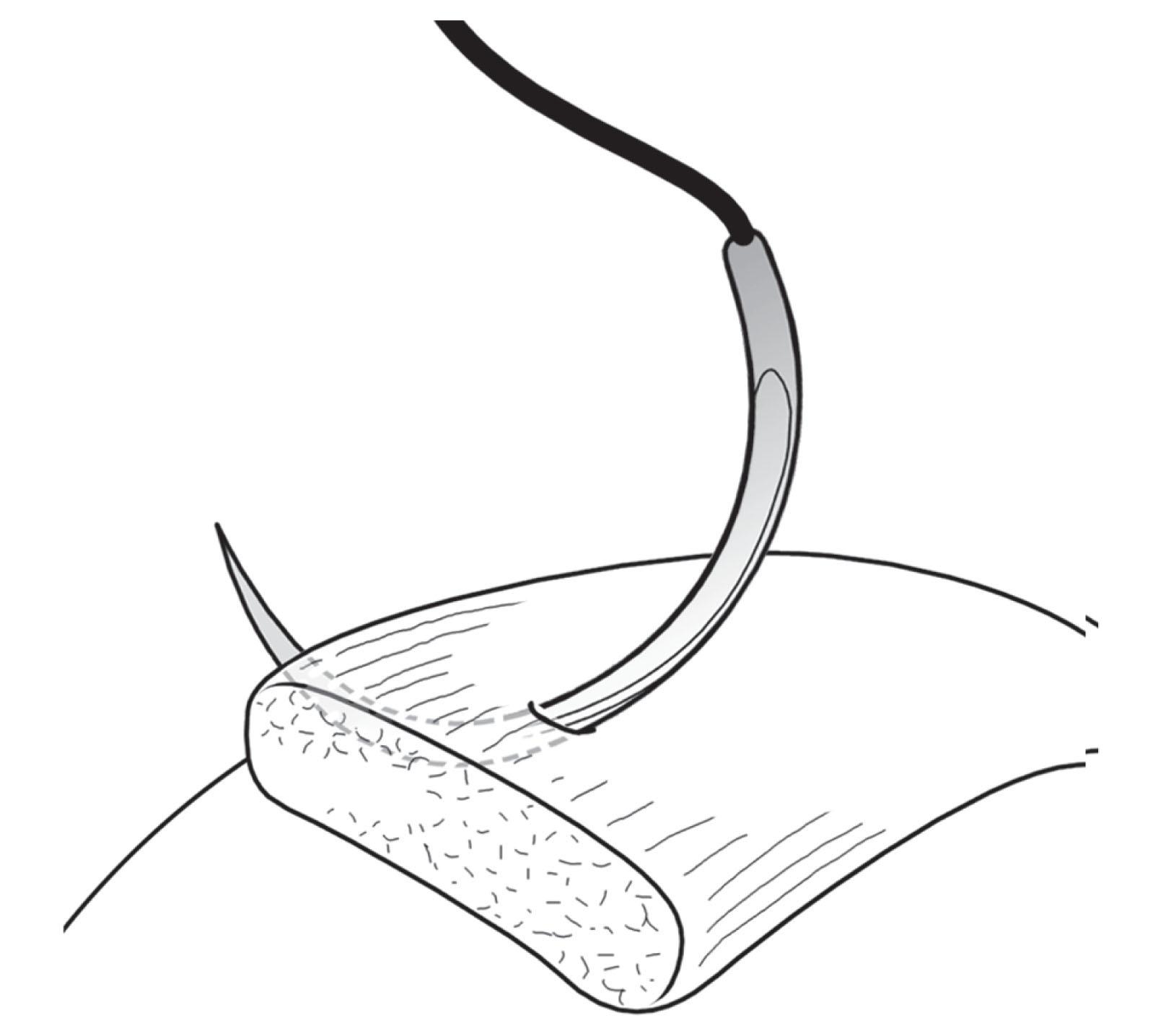
Following completion of the transverse pass, locking suture passes are made at the borders of the muscle near the insertion. The needle is passed full-thickness through the muscle from the posterior to the anterior aspect of the muscle and behind the transverse suture pass ( Fig. 88.19A ). The needle should not be passed through the anterior ciliary vessels, as this may result in significant bleeding. It is sometimes helpful to pass the needle around these vessels in order to ligate them and prevent bleeding when the muscle is detached from the globe. After the suture is passed full-thickness through the muscle, the needle holder is passed through the suture loop, grasping the needle and pulling it through the suture loop to create a locking bite ( Fig. 88.19B ). It is preferable to grasp the suture rather than the needle during this step to avoid damage to the needle.
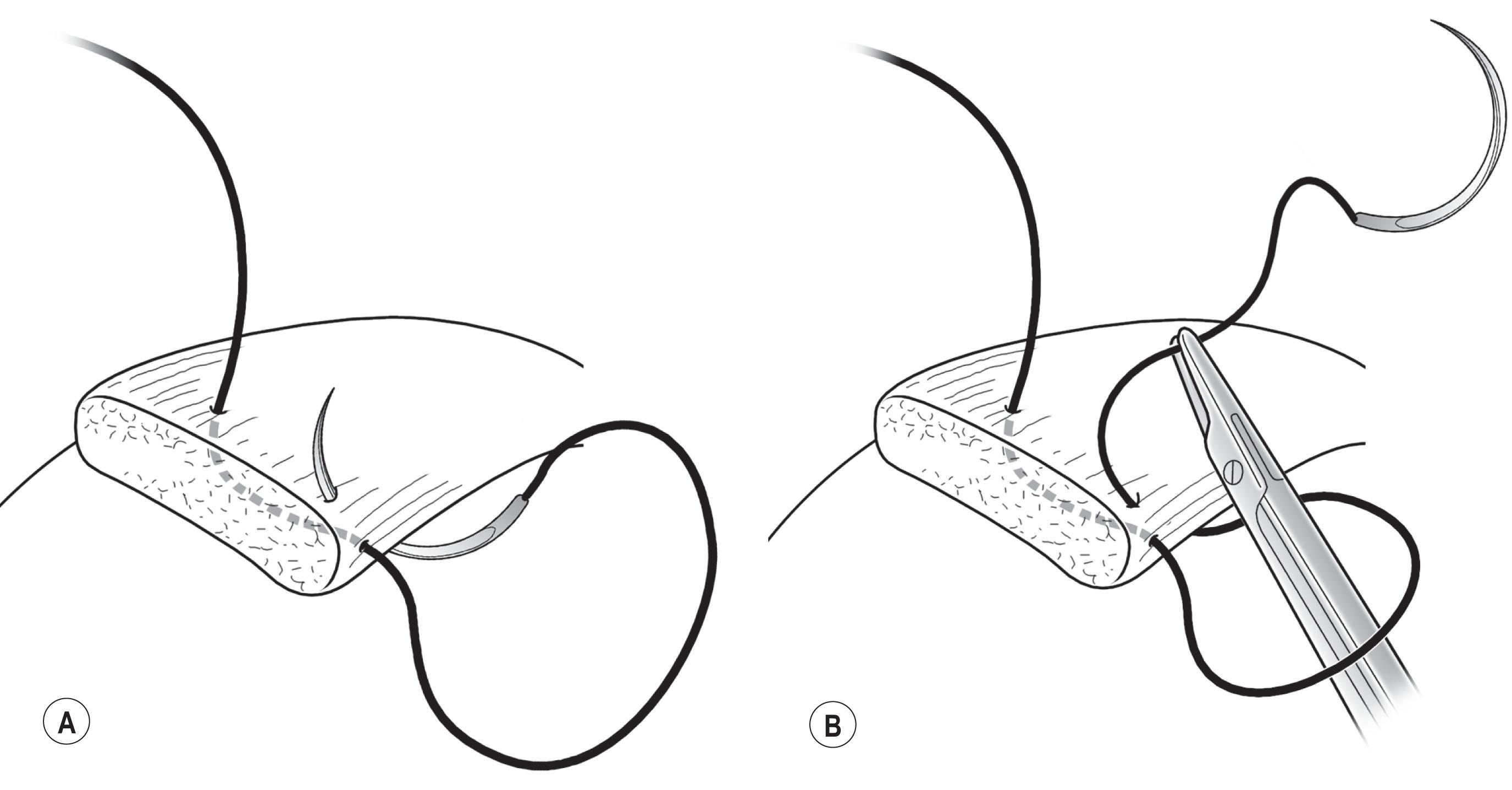
Become a Clinical Tree membership for Full access and enjoy Unlimited articles
If you are a member. Log in here